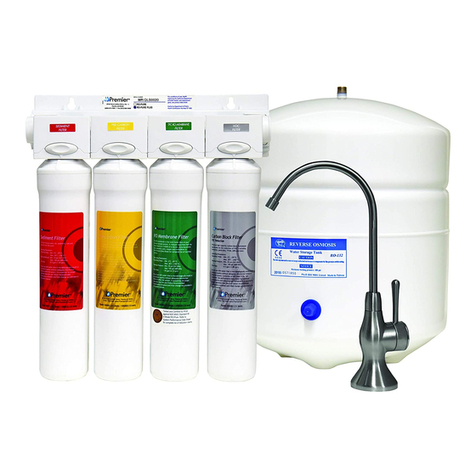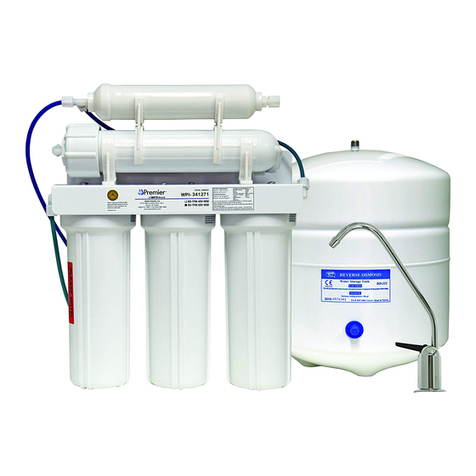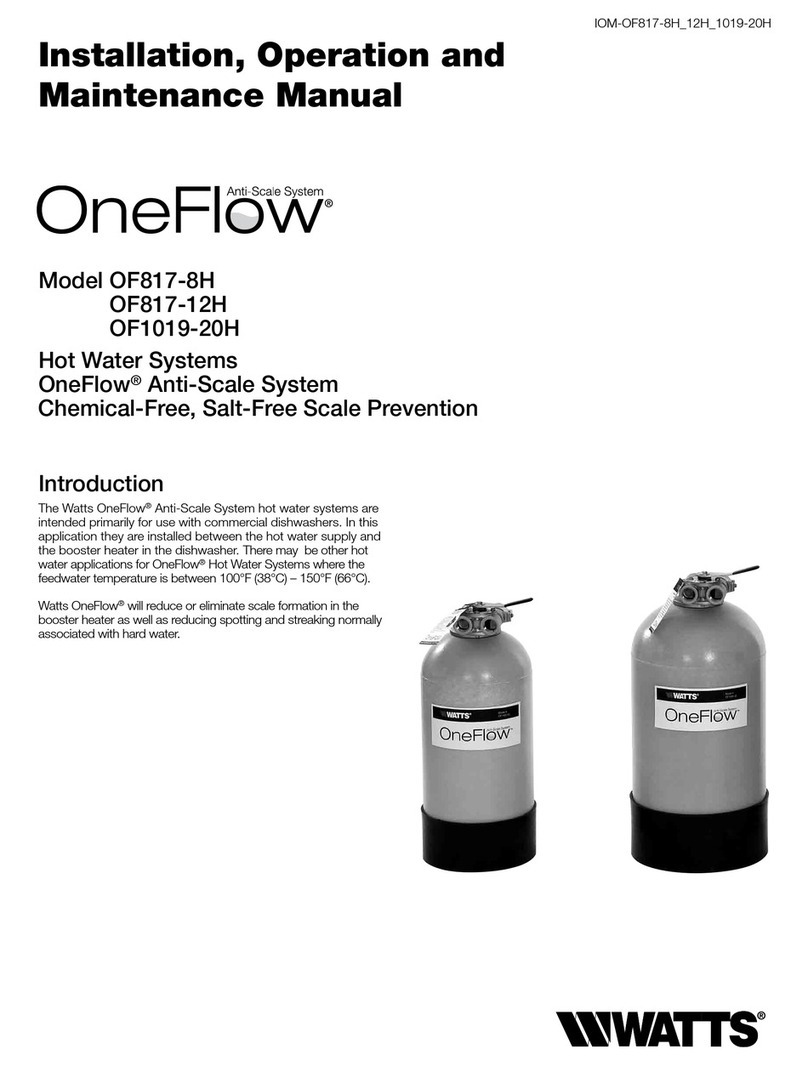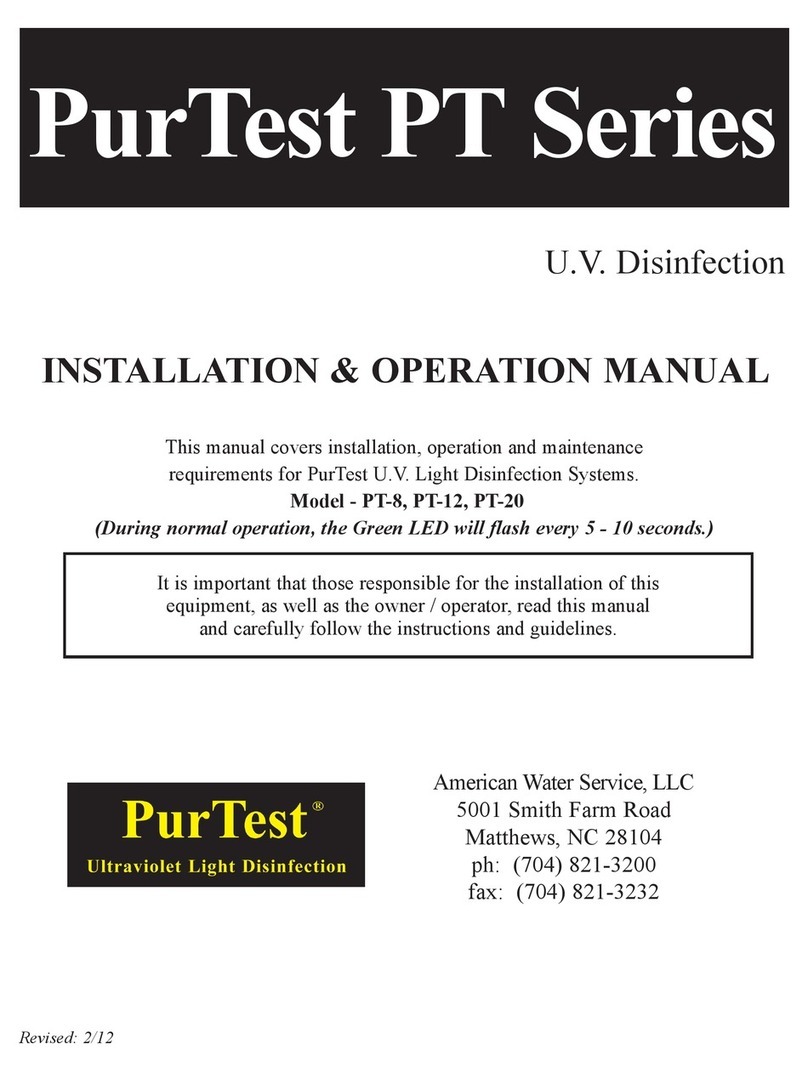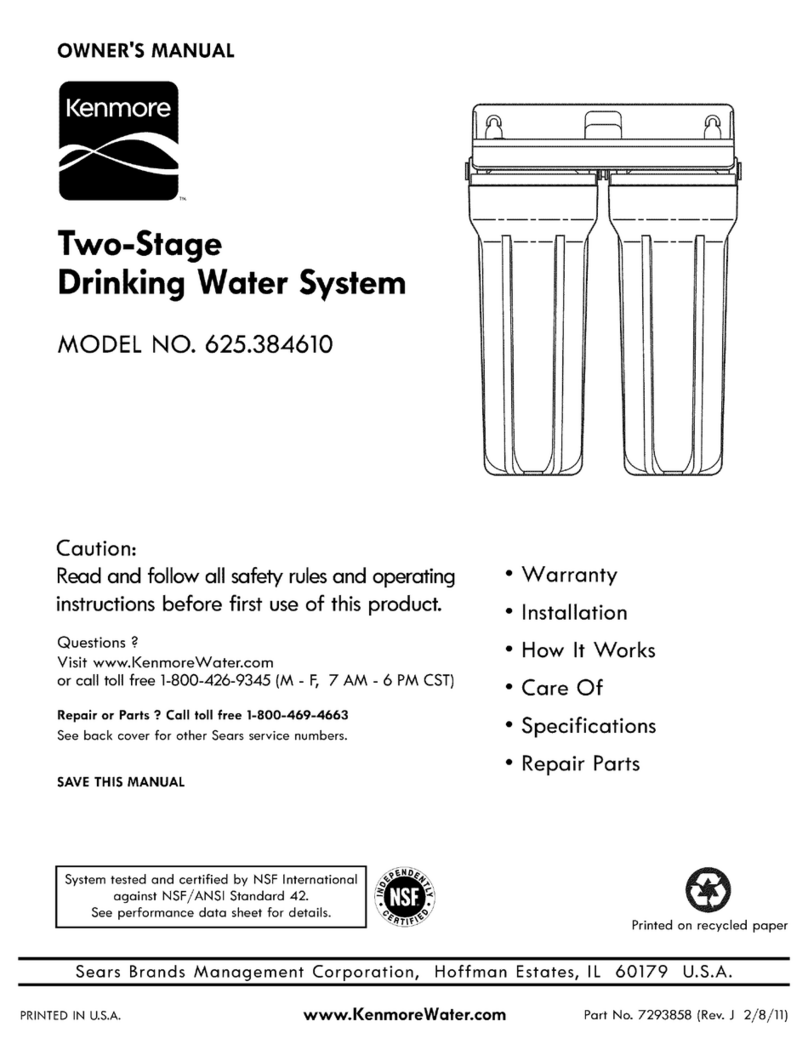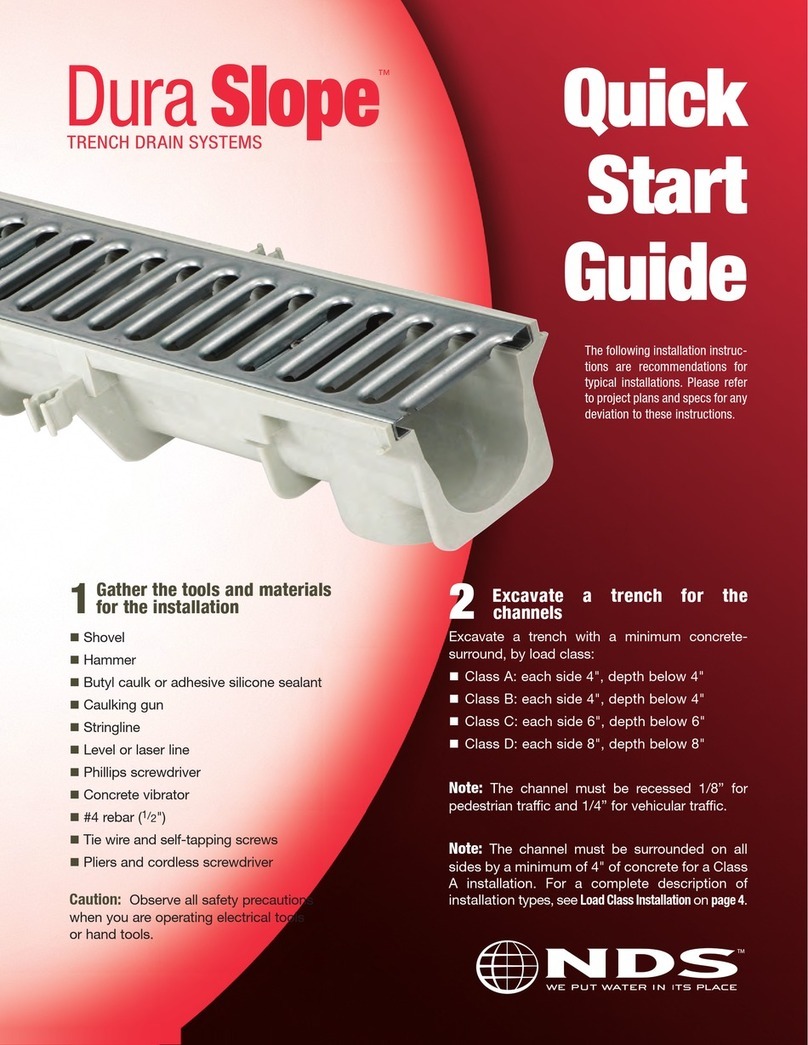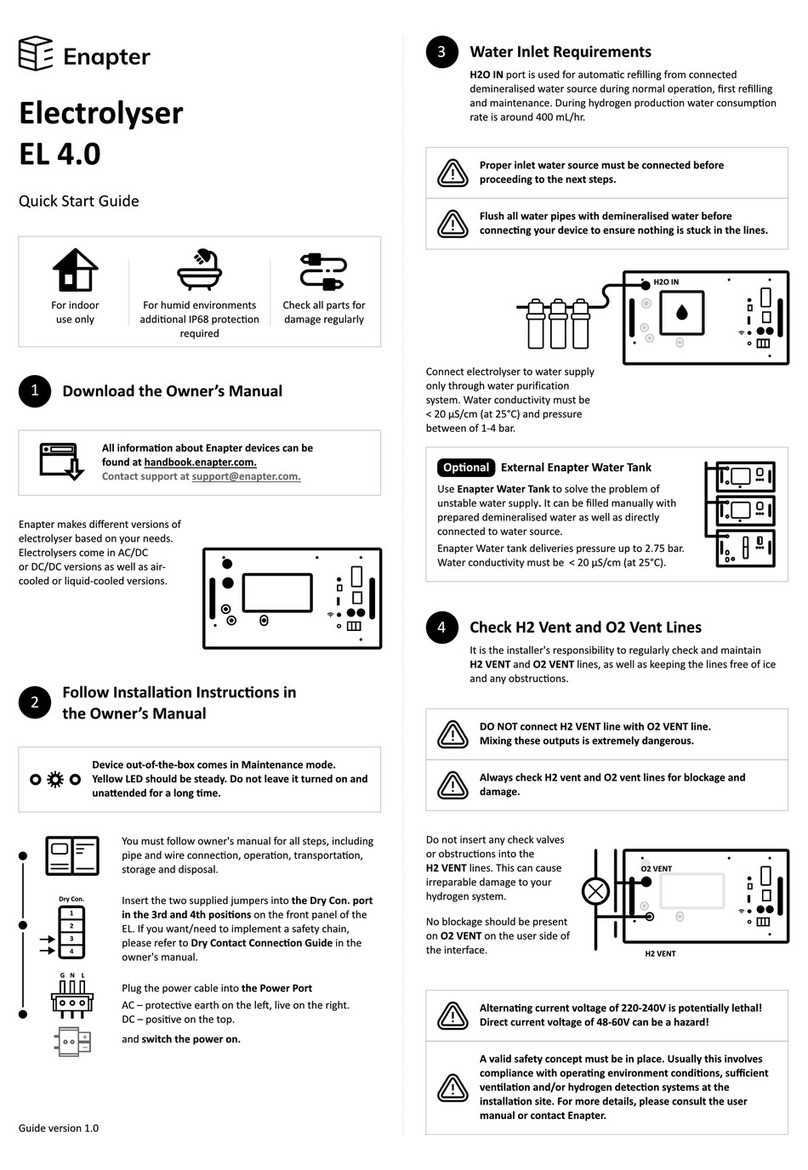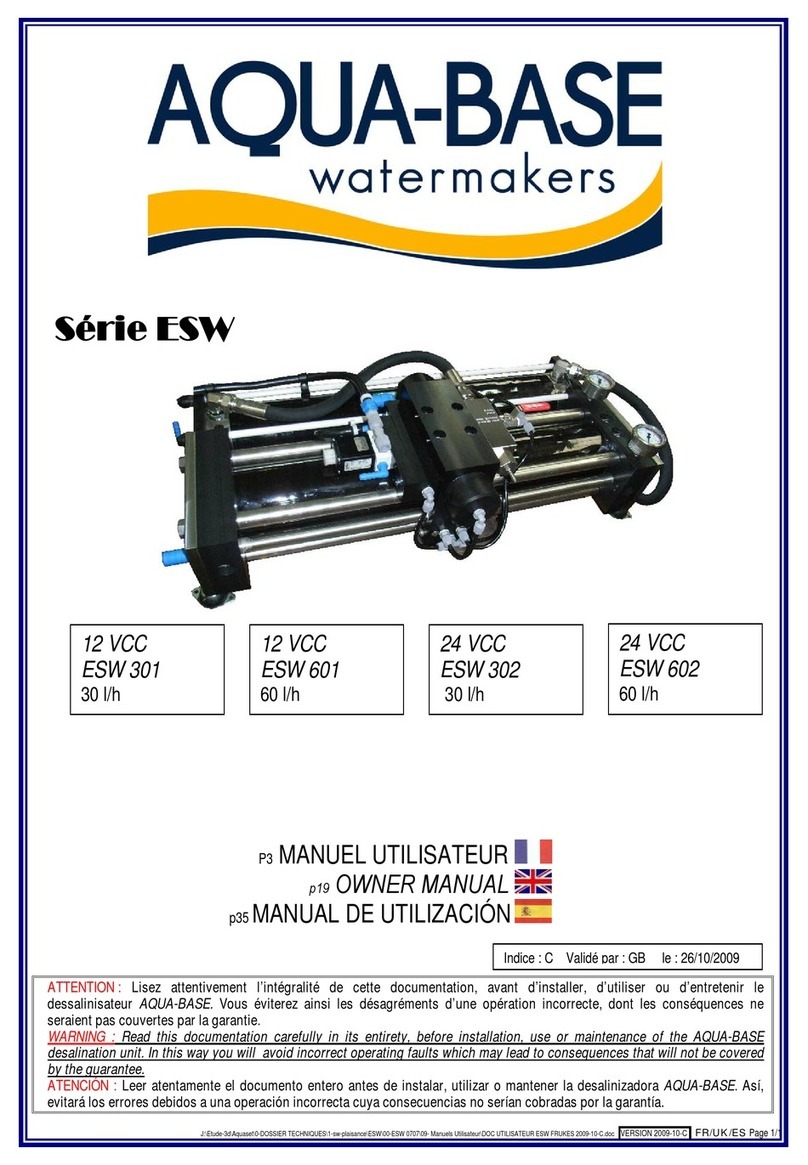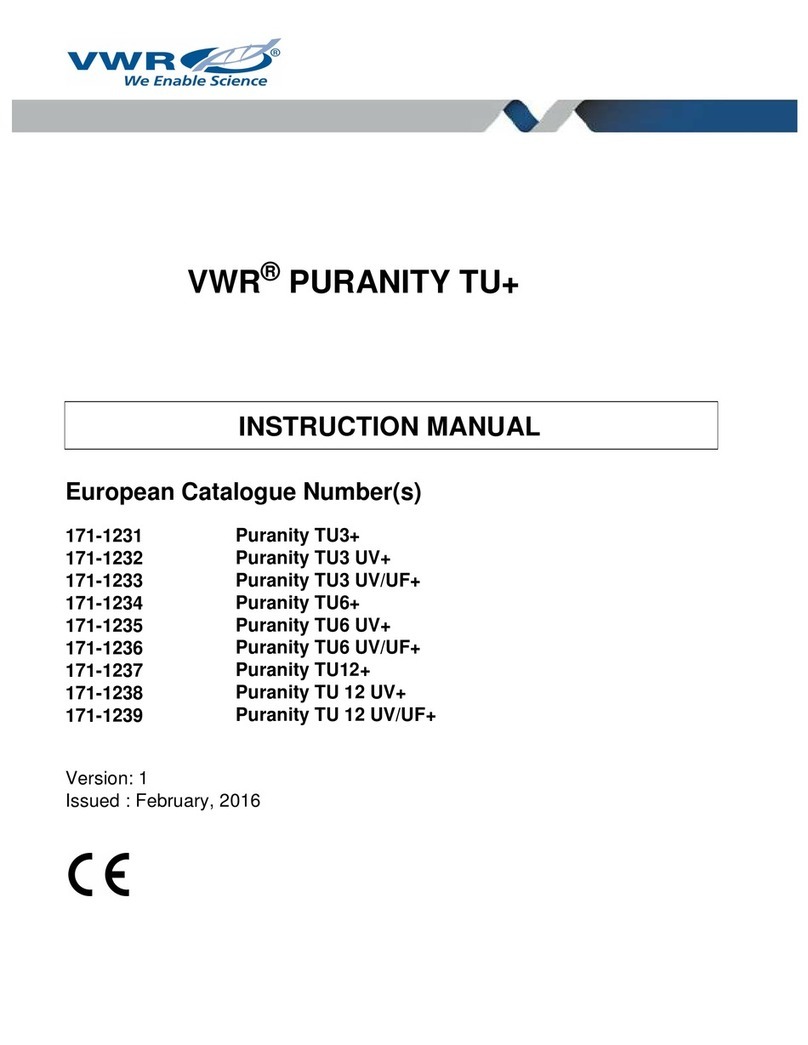Watts Premier RO-PURE User manual

Page 1
INSTALLATION, OPERATION AND MAINTENANCE MANUAL
Refer to enclosed warranty for operating parameters to ensure proper use with your water supply.
Watts Premier, Inc. 1725 W. Williams Drive C-20 Phoenix, AZ 85027
Phone: 800-752-5582 www.wattspremier.com Fax: 623-931-0191
Save manual for future reference
Warning
Please read carefully before proceeding with installation. Your failure to follow any attached instructions
or operating parameters may lead to the product’s failure and possible damage to property.
Manual Edition: 08/21/07
P/N 199404
Model: RO-PURE
System Tested and certified by WQA against NSF/ANSI
Standard 58 for the reduction of the claims specified on the
performance data sheet.
Available From:
®
freshwatersystems.com
serving you since 1989
CLICK HERE

Page 2
Service Record
Date of Purchase:__________ Date of Install:___________ Installed by:_____________
NOTES:
Date Sediment
Filter
(6 months)
Membrane
(2-5 years)
Carbon
Pre-Filter
(6 months)
Carbon
Post-Filter
(6 months)
Model Number:__________ Serial Number:___________

Page 3
4 Ways to Register
1. On-line at www.wattspremier.com
2. Call in your information 1-800-752-5582
3. Fax in your information 623-931-0191
First Name:_________________________ Last Name:____________________________
Address: ________________________________________ City: ____________________
State: _______________________________________ Zip Code: ___________________
Country: USA CANADA MEXICO OTHER ____________
Phone # ______-__________ -__________ Email Address: ______________________
Date of Purchase: ___________________ Date of Install: _______________________
Installed By: SELF Plumbing Professional Where Purchased: ____________
Model Number: _______________________ Serial Number: ____ - __________
Watts Premier, Inc. 1725 W. Williams Drive C-20 Phoenix, AZ 85027
Phone: 800-752-5582 www.wattspremier.com Fax: 623-931-0191
Register your product on-line and receive a 5% discount on your next on-line order, Plus receive reduced shipping.
4. Mail in the information.
Please complete the form below. Mail to: Watts Premier
1725 W. Williams Dr. C-20
Phoenix, AZ 85027
Fax this form directly to us.
Call and we will enter your information.
XXXXX XXXXXX
-
Watts Premier Inc. is concerned for the safety of your personal information. Watts Premier collects personal information when you register with
Watts Premier. This information is stored in our data base and we do not rent, sell, or share personal information with other people or nonaffiliated
companies. We reserve the right to send you certain types of communications such as direct mail, email, or by telephone relating to our products
or products that you have purchased. We limit access to your personal information to those employees who will directly provide you with services
or products in order to do their jobs. We want to offer you four ways to communicate with us. 1.Online, 2.Fax, 3.Telephone, and 4. Mail the form
below. By registering your product you will receive the full benefit of our warranty. Watts Premier will also send you a semiannual filter change
reminder beginning six months from date of installation. To insure the highest quality of your water, filters should be replaced every 6 months. If
you have any questions or comments please give us a call at 1-800-752-5582 M-F 8:00am -5:00pm MST.
Registering
will insure you
receive Watts
FREE
Filter
Reminder
Service
Thank you for selecting Watts Premier for your water filtration needs.
WARRANTY REGISTRATION
Iowa Department of Public Health - Sales in Iowa require this to be completed,
signed and returned. These signatures will be retained on file for two years.

Page 4
Thank you for yourpurchase of a state of the artWatts PremierReverse Osmosis (RO) water treatment system. Water
quality concerns are becoming more of a focus for the public. You may have heard about contaminants in the drinking water,
such as Arsenic, Perchlorate, Chromium, Cryptosporidium or Giardia. There may also be some local water issues such as
high levels of Lead and Copper. This Watts Premier water treatment system has been designed and tested to provide you
with high quality drinking water for years to come. The following is a brief overview of the system.
Your Reverse Osmosis System:
Osmosis is the process of water passing through a semi permeable membrane in order to balance the concentration of
contaminants on each side of the membrane.Asemi permeable membrane is a barrier that will pass some particles like clean
drinking water, but not other particles like arsenic and lead.
Reverse osmosis uses a semi permeable membrane; however, by applying pressure across the membrane, it concentrates
contaminants (like a strainer) on one side of the membrane, producing crystal clear water on the other. This is why RO
systems produce both clean drinking water and rinse water that is flushed from the system. This reverse osmosis system also
utilizes carbon block filtration technology, and can therefore provide a higher quality drinking water than carbon filtration
systems alone.
Your system is a three or four stage RO which is based upon separate treatment segments within the one complete water
filtration system. These stages are as follows:
Stage 1 (Not in three stage units) – Sediment filter, recommended change 6 months.
The first stage of your RO system is a five micron sediment filter that traps sediment and other particulate matter
like dirt, silt and rust which affect the taste and appearance of your water.
Stage 2 – Carbon filter, recommended change 6 months.
The second stage contains a 5 micron carbon block filter. This helps ensure that chlorine and other materials that
cause bad taste and odor are greatly reduced.
Stage 3- Membrane, recommended change 2-5 years.
Stage three is the heart of the reverse osmosis system, the RO membrane. This semi permeable membrane will
effectively take outTDS, Sodium and a wide range of contaminants such as Percholate, Chromium,Arsenic, Copper,
Lead as well as Cysts, such as Giardia and Cryptosporidium. Because the process of extracting this high quality
drinking water takes time, your RO water treatment system is equipped with a storage tank.
Stage 4- Carbon post filter, recommend change 6 - 12 months.
The final stage is a high quality carbon filter. Drinking water enters this filter after the water storage tank and it is
used as a final polishing filter.
Note: Filter life may vary based upon local water conditions or use patterns.
System Maintenance
Just because you can not taste it, does not mean that it is not there. Contaminants such as Lead, Chromium and Arsenic are
undetectable to the taste. Additionally, over time if you do not replace the filter elements, other bad tastes and odors will
be apparent in your drinking water.
This is why it is important to change out your filters at the recommended intervals as indicated in this system manual. When
replacing the filter elements, pay special attention to any cleaning instructions. Should you have any further questions please
refer to our website at www.wattspremier.com or call our customer service dept. at 1-800-752-5582.
Available From:
®
freshwatersystems.com
serving you since 1989
CLICK HERE

Page 5
Thank you for your purchase of a Watts Premier Reverse Osmosis system. With proper installation and
maintenance,this systemwillprovide youwith highquality waterfor yearsto come.All ofPremier’swater
enhancement products are rigorously tested by independent laboratories for safety and reliability. If you
have any questions or concerns, please contact our customer service department at 1-800-752-5582
(outside USA 623-931-1977) or refer to our on-line troubleshooting at www.wattspremier.com.
Table of Contents
Service Record...................................................................................................................................... 2
Warranty Registration............................................................................................................................ 3
Operational Parameters ........................................................................................................................ 6
Contents of Reverse Osmosis System.................................................................................................. 6
Tools Recommended For Installation.................................................................................................... 6
Drill a Hole for the Faucet in a Porcelain Sink....................................................................................... 7
Punch a Hole for the Faucet in a Stainless Steel Sink..........................................................................7
Watts Chrome Monitor & Non-Monitored Faucet Installation................................................................ 8
Green Tube Connection (From RO Module To TheAdapta Valve) ...................................................... 9
Adapta Valve Installation ...................................................................................................................... 9
Reverse Osmosis Module Mounting...................................................................................................... 9
Drain Saddle Installation...................................................................................................................... 10
Tank Ball Valve Installation.................................................................................................................. 10
How To Use Quick Connect Fittings For Tubing Connections..............................................................11
Blue Tube Connection (From RO Module To The Tank)...................................................................... 12
Blue Tube Connection (From RO Module To The Faucet).................................................................. 12
Black 3/8” Tube Connection (From The Faucet To The Drain Saddle)................................................ 12
Red Tube Connection (From The Faucet To The Flow Restrictor)...................................................... 13
Start up Instructions............................................................................................................................. 13
6 Month System Maintenance............................................................................................................. 14
Membrane Replacement .................................................................................................................... 14
Check Air Pressure in the Tank ........................................................................................................... 15
Parts List / Unit Drawing ..................................................................................................................... 15
Trouble Shooting ................................................................................................................................ 16
Performance Data Sheet..................................................................................................................... 17
Arsenic Fact Sheet.............................................................................................................................. 18
Other Products from Watts Premier ............................................................................................... 19-21
Limited Warranty ................................................................................................................................. 22

Page 6
Hardness: Recommended hardness not to exceed 10 grains per gallon, or 170ppm. System will
operate with hardness over 10 grains but the membrane life may be shortened. Addition of a water
softener may lengthen the membrane life.
Installation needs to comply with state and local plumbing regulations. This system is intended
to be installed on the cold water line only.
1 Tank
1 RO Module (complete with filters)
1 Parts Bag
1 Faucet Bag
1 Manual with Warranty Card
Note: A 4 Stage RO System has 4 quick change cartridges and a 3
Stage RO System has 3 quick change cartridges.
If any of the items are missing please contact Premier prior to installing.
Tools Recommended For Installation
√ 1 1/4" Hole Saw Bit for Faucet opening
√ Round Knock out Punch for Stainless Sinks 1 ¼”
√ Adjustable Wrench
√ Sharp Knife
√ 1 / 2" Open End Wrench
√ Phillips Screw Driver
√ Needle Nose Pliers – Adjustable Pliers
√ Electric Drill
√ 1/8", 1/4" & 3/8" Drill Bits
Contents of Reverse Osmosis (RO) System
Operating Temperatures: Maximum 100°F (37.8°C) Minimum 40°F 4.4°C)
Operating Pressure: Maximum 85 psi (7.43 g/cm2) Minimum 40 psi (2.80 kg/cm2)
pH Parameters: Maximum 11 Minimum 2
Iron: Maximum 0.2 ppm
TDS (Total Dissolved Solids): < 1800 ppm
Turbidity: < 5NTU
Note: Reverse Osmosis water should not be run through copper tubing as the purity of the water will
leach copper causing an objectional taste in water and pin holes to form in tubing. Watts supplies
speciality filters (part number 107008) that can be used if copper tubing follows the Reverse Osmosis
unit. Be sure to follow any state or local regulations during installation.
Operational Parameters
Note: The operating pressure in your home should be tested over a 24 hour period to attain the
maximum pressure. If operating pressure is above 85 psi a pressure regulator is recommended. If it
is above 100 psi then a pressure regulator is required (see part number 107001 on page 20).

Page 7
Note:
Step 3
Step 4
Determine desired location for the faucet on your sink and place a
piece of masking tape on location where the hole is to be drilled. Mark
the center of the hole on the tape.
Using a variable speed drill on the slowest speed, drill a 1/8” Pilot
hole through both porcelain and metal casing of sink at the center of
the desired location. (If drill bit gets hot it may cause the porcelain to
crack or chip).
Using a 1 ¼” hole saw, proceed to drill the large hole. Keep drill speed
on the slowest speed and use lubricating oil or liquid soap to keep the
hole saw cool during cutting.
Make sure the surroundings of the sink are cooled before mounting the
faucet to the sink after drilling. Remove all sharp edges with a file.
Step 1
Step 2
Drill a Hole for the Faucet in a Porcelain Sink
Most sinks are predrilled with 1 ½” or 1 ¼” diameter hole that you can use for your RO
faucet (If you are already using it for a sprayer or soap dispenser, you will need an
additional hole for the faucet).
Porcelain sinks are extremely hard and can crack or chip easily. Use extreme caution when
drilling. Premier accepts no responsibility for damage resulting from the installation of
faucet.
Punch a Hole for the Faucet in a Stainless Steel Sink
Step 5
If mounting faucet to a Stainless Steel Sink you will need a 1 ¼”
hole punch. The faucet opening should be centered between the
back splash and the edge of the sink, ideally on the same side as
the vertical drain pipe.
Drill a ¼” pilot hole. Use the appropriate sized hole punch and an
adjustable wrench to punch the hole in the sink.
Once the hole is punched out, the faucet can be installed.
Note:

Page 8
Gather and identify the faucet pieces.
Remove faucet base & faucet spout from their respective
plastic bags. From above the sink, feed the faucet base,
tubing & toggle bolt down through the 1¼” mounting hole in
the sink. Align the faucet base so that the handle is on the
right side and the base is sitting flush on the sink top. Ensure
that the soft rubber gasket is uniformly positioned in between
the base and the top of the sink.
Lift faucet base and remove the white paper from the gasket
and stick it to the top of the sink in the appropriate position for
the faucet base. Turn the handle down (towards you) to the
“ON” position to reveal the tightening screw (located where
the spout will be inserted). Using a phillips head screwdriver,
turn the screw clockwise until the toggle bolt secures the
faucet base snug onto the sink top, do not over torque toggle
bolt (5lb.in. max)
Once the faucet base is securely fastened to the sink top,
insert the faucet spout into the faucet base until it is fully
seated. Turn the handle up (vertical) to the “OFF” position.
Completion of faucet installation (tubing connections) will be
donelaterinthismanual.RefertotheBlackTube Connection
(page 12), Red Tube Connection (page 13), and Blue Tube
Connection (page 12) sections of this manual.
Insert the battery drawer with the battery into the base of the faucet until it is flush.
NOTE: The + side of the battery faces up. The compartment drawer will not slide in if the battery is installed upside
down.
When the battery is first installed, both the red and green lights will flash to indicate that both lights are functional. Thereafter,
it will flash green only when the faucet handle is turned to the “ON” position. When your system is ready to be serviced
(approximately six months) you will see the light flash red when the handle is turned to the “ON” position. Refer to the Six
Month Maintenance (page 14) section of this manual for filter replacement.
NOTE: If your water usage is high the red light may activate sooner than six months indicating the need for filter
replacement.
This faucet provides an electronic monitor that will tell you when it is time to replace the filters in your water
treatment device. The light indicator will be green for the life of the filter, turning red once the life of the filter has
been reached. This can occur after six months of use, or sooner for heavy water usage. To reset the electronic
monitor during replacement of filters, simply slide out the battery from the faucet and reinsert. The battery life is
expected to last one year, however, for heavy use the battery may need to be replaced sooner. For replacement,
look for battery number CR2354 (Watts p/n:116082) which is available at your local battery store or contact Watts
Premier at 800-752-5582. You can also order online at www.wattspremier.com.
WATTS Premier Chrome Monitored & Non-Monitored
(Top Mount) Faucet Installation
Step 6
Step 7
Step 8
Step 9
Step 10
Faucet Battery Installation
Minimum Maximum
Mounting Hole Size 1.00” 1.25”
Torque on Toggle Bolt 5lb.in. (max)
If your faucet is equipped with the monitoring function please proceed to the next step,
otherwise please proceed to the next page.
Available From:
®
freshwatersystems.com
serving you since 1989
CLICK HERE

Page 9
Hot Supply Cold Supply
Adapta Valve Installation - Part# 134007
Turn off the cold water supply to the faucet by turning the angle stop valve
completely off.
Step 14
Step 15 Attach adapta valve as illustrated in the photos above, choosing the configuration that fits
your plumbing. (When attaching the adapta valve to straight pipe threads, use teflon tape on
the treads.)
Caution: Water supply line to the system must be from the cold water supply line only. Hot water
will severely damage your system.
Configuration for 3/8” compression fittings
Configuration for 1/2” compression fittings
Green Tube Connection (From RO Module to The Adapta Valve)
The green tubing may be removed from the quick connect fitting on the RO Module to ease
with the installation of the Adapta Valve to the supply line (see page 11 for quick connect
fitting use directions). Make sure to re-attach the green tube to the RO Module after the
Adapta Valve has been installed.
Remove a brass nut, plastic sleeve and brass insert from the
parts bag. Place nut on the green tube (coming from the RO
Module) first, then the plastic sleeve (small taper end of plastic
sleeve must point to the end of tube) and then insert the brass
insert into the end of the tube.
Insert the green tube into the ¼” opening on the Adapta Valve
(supplied in the parts bag) until it stops. Slide nut and sleeve
down and thread onto the male pipe threads. Use a ½” wrench
to securely tighten.
Step 11
Step 13
Step 12
Adapta Valve - Part# 134007
Reverse Osmosis Module Mounting
Step 16 Determine best location for the RO module to be mounted to allow
for future system maintenance. The parts bag has 2 self tapping
screws. Using a phillips screwdriver, screw them into the cabinet
wall using the mounting bracket as a guide.
Do not cut any RO system tubes at this timeNote:
Note: If the green tubing was removed from the quick connect fitting on the RO Module in Step
13, re-attach it to the RO Module now (see page 11 for quick connect fitting use directions).

Page 10
Drain Saddle fits standard 1 ¼” – 1 ½” drain pipes
Drain Saddle Installation - Part# 164016
Step 17
Step 18
Step 19
Step 20
Step 21
Teflon tape must be applied in a clockwise direction. Wrap (7 to
12 turns) around the male pipe threads (MPT) on the stainless
steel fitting on top of the tank.
The small square black foam gasket with a circle cut out of the
middle must be applied to the inside of the drain saddle. Remove
sticky tape backing and stick to the drain saddle as shown.
1 Black compression nut 1 Semicircle bracket with opening
2 Screws 1 Foam washer
2 Nuts for screws 1 Semicircle bracket
Gather the pieces of the drain saddle
Tank Ball Valve Installation - Part#: 134018
Caution: Do not over-tighten the screws. Over-tightening screws may crack
the drain saddle.
Caution: If you have a garbage disposal, do not install the drain line near it.
Installation of the drain line must be either above the disposal, or if
a second sink drain is available, install it above the cross bar on the
second sink. Installation of the drain line near a garbage disposal
may cause the drain line to plug. If no other installation of drain line
is available, Watts offers drain line installation kits that can be used
with garbage disposals (part numbers 164014 and 164020).
Assemble the drain saddle around the drain pipe at least 1 ½”
above the nut of the P-trap to allow for the removal of the P-trap if
necessary. Using a Philips screw driver tighten screws evenly and
securely on both sides of the drain saddle.
Insert a ¼” drill bit into the opening of the drain saddle and drill a
hole in to the drain pipe. NOTE: Take extreme caution to only
drill through one side of the drain pipe and not all the way
through.
Attach black compression nut to the drain saddle, but do not tighten
at this time. The black tubing will be installed later.
Thread the quick connect ball valve (supplied in the parts bag) onto
the stainless steel connector on the tank.
Note: Do not over-tighten plastic connections.

Page 11
How To Use the Quick Connect Fittings For Tubing Connections
To make a connection, the tube is simply pushed into the fitting. Place a piece of tape 1/2” from end
of tube to indicate how far the tube should be inserted. The unique patented locking system holds the
tube firmly in place without deforming it or restricting flow.
NOTE: These diagrams are just to show how the quick connect fittings work, your product may not
have this exact connector part.
It is essential that the outside diameter be free of score
marks and that burrs and sharp edges be removed before
inserting into fitting.
Fitting grips before it seals. Ensure tube is pushed into
the tube stop.
Push the tube into the fitting, to the tube stop. The collet
(gripper) has stainless steel teeth which hold the tube
firmly in position while the O-ring provides a permanent
leak proof seal.
Pullonthetubetocheckthatit is secure. It is a good practice
to test the system prior to leaving site and /or before use.
To disconnect, ensure the system is depressurized before
removing the tube. Push in collect squarely against face
of fitting. With the collet held in this position, the tube can
be removed. The fitting can then be reused.
Available From:
®
freshwatersystems.com
serving you since 1989
CLICK HERE

Page 12
Blue Tube Connection (From The RO Module To TANK)
Position tank in desired location. Stand it upright or lay it on
its side (using the black plastic stand). Measure the blue tube
(marked “TANK”) from the RO module over to the tank and cut
it to length leaving a straight edge on the end of the tube. Then
insert the tube into the quick connect fitting on the tank ball
valve. Make sure the tube is pushed in all the way to the tube
stop (see page 11 for quick connect fitting use directions).
Step 22
Black 3/8” Tube Connection (From FAUCET To The DRAIN SADDLE)
Measure the 3/8” black tube from faucet to the black drain
saddle so that it is as short and straight as possible, then
make a straight cut through tube.
Remove black plastic nut from drain saddle. Slip black tube
through black nut. Insert black tube into the opening in the
drain saddle and tighten the black nut securely.
This is a gravity fed line, if there is any dip or kink in the tube
the rinse water will not flow into the drain properly. Water
will back up and come out the air gap hole in the back of the
faucet base.
The tubing must be as SHORT and STRAIGHT as possible, making a downward slope
from faucet to drain saddle to allow for proper drainage.
Step 26
Note:
Note:
Step 25
Step 23 Determinewherethe 3/8”blue tubingfromthe faucetand the1/4”
blue tubing (marked “FAUCET”) from the RO Module would join
together comfortably. Cut the tubes leaving a straight cut on both
tubes.Insert the 1/4” blue tube (marked “FAUCET”) from the RO
module into the 1/4” end of the 1/4” x 3/8” quick connect union
supplied in the parts bag. Make sure the tube is pushed in all
the way to the tube stop.
Blue Tube Connection (From The RO Module To FAUCET)
Step 24 Insert the 3/8” blue tube from the faucet into the remaining 3/8”
open end of the 1/4” x 3/8” quick connect union. Make sure the
tube is pushed in all the way to the tube stop.

Page 13
Step 27
Red Tube Connection (From FAUCET To The FLOW RESTRICTOR)
Determine where the 1/4” red tubing from the faucet and
the open end of the flow restrictor (attached to the end
of the 1/4” black tubing from the RO Module) would join
together comfortably. Cut the tubes to length, making
sure the cut ends are straight. Unscrew the supplied
compression nut from the open end of the flow restrictor
and push the nut onto the end of the red tube. Insert the
red tube (with attached nut) into the open end of the flow
restrictor making sure the tube is pushed in all the way to
the tube stop. Once the red tube is fully inserted, securely
tighten the compression nut onto the flow restrictor.
Turn on the incoming cold water. Open theAdapta-Valve installed earlier in this manual
(page 9). Check the system for leaks and tighten any fitting as necessary. (Check over the
next 24 hours to ensure no leaks are present).
Open the RO faucet and leave it open until water begins to trickle out. (it will come out
slowly and may sputter at first. The water may look dark, which is carbon from the final
filter. This is normal and will go away). Once the water begins to trickle out, close the RO
faucet.
The tank will take between 4 to 6 hours to fill completely (depending on the size of the
membrane, local water temperature and pressure). After the tank has filled, open the RO
An optional ice maker kit (not included) may be purchased from Watts Premier by calling
1-800-752-5582 or buy on-line at www.wattspremier.com. If system is connected to an ice
maker, turn the ice maker off (or do not allow water to flow to the ice maker) until Step 3
flushing is complete and the tank has been allowed to completely fill. Connection from the
RO to the ice maker system should have an in-line valve installed before the ice maker so it
can easily be closed to prevent water flowing to the ice maker during start up and periodic
maintenance. Your RO tank must be allowed to fill up in order for the ice maker system to
work properly. (If you are installing an ice maker kit from Watts, tee off after the final filter).
Complete the warranty registration (page 3) and submit to Watts Premier. Premier uses
this information to provide the latest information about water quality concerns as well as
a free filter change reminder service. Inspect the reverse osmosis system periodically to
ensure the unit is functioning properly.
Start up Instructions
Step 3
Step 4
Step 5
Step 2
Step 1
Faucet to flush the tank completely to remove carbon particles from final filter. Repeat this
step two more times. The fourth tank can be used for drinking. Note: The flushing of the
tank 3 times is only necessary during initial installation. This should take about a day to
complete.
Available From:
®
freshwatersystems.com
serving you since 1989
CLICK HERE

Page 14
√ One sediment filter (RED Label - 4 Stage Only P/N: 105311)
√ One carbon pre-filter (YELLOW Label P/N: 105351)
√ One carbon post-filter (BLUE Label P/N: 105341)
√ Towel to catch water from filter housings.
6 Month System Maintenance
Place the towel under the RO module to catch any excess water that
drips out from the filters during the changeover.
Step 1
Items needed:
Your RO module is equipped with valved heads which will automatically
turn off the water supply to each filter when the filter is released, thus
you do not need to turn off the incoming water supply at theAdapta-
Valve. The faucet must be off when filters are replaced.
NOTE:
To make the removal of the filter housings easier, the heads & housings
may be lifted up to 90 degrees as shown in the pictures to the right.
Starting with the sediment filter (RED Label) push & hold the button on
the valved head and pull downward (from the head) to remove the filter
housing. Release button and discard old filter housing.
Step 2
Make sure to remove the cap off of the new replacement filter. Insert the
new filter housing into the valved head until you hear an audible “click”
(the button does not need to be pressed to install new filters).
Step 3
Repeat this procedure for the 2nd and 4th housings. When finished
flush your tank completely once to remove any natural carbon fines from
the RO system. Check over the next 24 hours to ensure no leaks are
present.
Step 4
Membrane Replacement (GREEN Label P/N: 105331)
Membranes have a life expectancy of between 2 and 5 years, depending on the incoming water
conditions and the amount of use of the RO system.
Normally, a membrane would be replaced during a semiannual or annual filter change. However, if
at any time you notice a reduction in water production or an unpleasant taste in the reverse osmosis
water, it could be time to replace the membrane. A water sample may be sent into Premier for a
free test or a TDS (total dissolved solids) monitor can be purchased from Watts Premier to test the
incoming and reverse osmosis water. Membranes should be replaced when TDS reduction is 80% or
less. TDS Monitors are available for purchase on page 20 of this manual.
To send a water sample, include ½ cup of tap water and ½ cup of the system’s reverse osmosis water
in clean containers. Clearly mark each container. Watts Premier will test the water and call or mail
you the results.
To change your membrane follow the instructions for the 6 Month System Maintenance
(previous section). The procedure to remove and change the membrane housing is the
same as all the other filter housings on the RO module.
Step 1
Check over the next 24 hours to ensure no leaks are present.Step 2
Watts Premier sells a filter change kit which includes all replacement filters
needed. Call 1-800-752-5582 or buy on-line at www.wattspremier.com.
This reverse osmosis system contains a replaceable component (the RO membrane) which is critical to the efficiency of
the system. Replacement of this reverse osmosis membrane should be with one of identical specifications as defined by
Watts Premier to assure the same efficiency and contaminant reduction performance.

Page 15
Check air pressure only when tank is empty of water!
Check air pressure in the tank when you notice a decrease in
available water from the RO system.
It is recommended that you drain the tank of water, and then
pump up the RO tank in order to ensure all water is out of the
tank. Air can be added with a bicycle pump using the schrader
valve that is located on the bottom side of the tank.
Once all water in the tank is purged out, check air pressure of the
tank. If you added too much air to the tank and it is higher than
5 - 7 psi, allow air out until you have 5 - 7 psi in the tank.
Check Air Pressure in the Tank
Step 1
Note:
Step 2
Item # Part # Description
1 531150 RO4-PNP-11-50 (Head & 4 Filter Cartridges)
2 125089 FITTING-ELBOW-90-QC-1/4TX1/4I
3 622036 FLOW RESTRICT-550-STAND ALONE
4 134003 VALVE-SHUT OFF 1/4” Q.C. (RES)
5 119007 TANK-3 GALLON-METAL-WHITE
7 134007 ADAPTA VALVE
8 116074 FAUCET-AG-WATTS-CHROME-MONITOR
9 134018 VALVE-BALL-ELB-1/4QCX1/4F
* The reverse osmosis system contains a replaceable treatment component, critical for the effective reduction of total
dissolved solids and that the product water shall be tested periodically to verify that the system is performing properly
Item # Part # Description
10 125037 FITTING-UNION-1/4”T X 3/8”T-DM
11 164016 DRAIN SADDLE 3/8”
12 119028 TANK STAND
13 610109 GREEN TUBING
14 610113 BLACK TUBING
15 610117 BLUE TUBING
Parts List
3/8" BLACK TUBE
1/4" RED TUBE
3/8"
BLUE
TUBE
1/4"
GREEN
TUBE
DRAIN SADDLE
FLOW RESTRICTOR
SHUT OFF VALVE
ADAPTA
VALVE
TANK BALL
VALVE
3/8" x 1/4" UNION 1/4" BLUE TUBE
1/4" BLUE TUBE
1/4" BLACK TUBE

Page 16
TROUBLE SHOOTING
Problem Cause Solution
1. Low/Slow Production Low Water Pressure Assure a minimum of 40 psi incoming water pressure.
Premier sells a booster pump if home water pressure is
low. Maker sure water supply is turned on and Adapta
Valve is all the way open
Crimps in tubing Check tubing and straighten or replace as necessary.
Clogged pre-filters Replace pre-filters.
Fouled membrane Replace membrane and flow restrictor.
2. Milky colored Water Air in system Air in the system is a normal occurrence with initial
start up of the RO system. This milky look will
disappear during normal use within 1-2 weeks. If
condition reoccurs after filter change, drain tank 1 to 2
times.
3. Water constantly Low water pressure See #1 Above
running unit will not
shut off Crimp in supply tube Check tubing and straighten or repair as necessary
4. Noise / Water from Crimp or restriction in Check tubing and straighten or repair as necessary.
faucet vent hole or noise drain line Straighten all drain lines. Clear blockage. Cut off any
from drain Excess tubing
Drain tube clogged Caused from dishwasher or garbage disposal.
Disconnect the 3/8” black line at the drain, clean the
3/8” black line out with a wire, then reconnect. Blowing
air through the line will not always remove the clog.
5. Small amount of water in System starting up Normally it takes 6-10 hours to fill tank. Note: low
storage tank incoming water pressure and/or temperature can
drastically reduce production rate.
Low water pressure See #1 above.
To much air in tank Tank air pressure should be 5 psi when empty of water.
If below 5 psi add air or bleed if above 5 psi.
Check only when tank is empty of water.
See previous page.
6. Water leaks from the filter / Not properly inserted Re-insert the filter / membrane housing.
membrane housing
7. Low water flow from faucet Check air in tank Use a Digital Air Gauge for best results. The empty
tank pressure should be 5-7 psi. To reset the air pressure
in the tank turn off water supply and drain tank by
opening faucet. When water stops flowing out of the
faucet. Remove schrader valve cover pump air into
tank until water stops flowing from the faucet. Release
the air out of the schrader valve until you reach 5-7 psi.
Replace schrader valve cover. Turn on Water.
Available From:
®
freshwatersystems.com
serving you since 1989
CLICK HERE

Page 17
Watts Premier Inc.
1725 W. Williams Drive C-20
Phoenix, AZ 85027 USA
California Certification # 07-1882
RO-Pure
System conforms to NSF Standard 58 for specific claims.
RECOMMENDED REPLACEMENT PARTS AND CHANGE INTERVALS:
Note: Depending on incoming feed water conditions replacement time frame may vary.
Description Change time Frame Cost
Sediment Pre-filter: #105311 6 Months $12.50
Carbon Pre-filter: #105351 6 Months $19.30
Final Carbon filter #105361 12 Months $19.30
R.O. Membrane: #105331 2 to 5 years $72.95
This system has been tested according to NSF/ANSI 58 for reduction of the substances listed below. The concentration of the indicated substances in water
entering the system was reduced to a concentration less than or equal to the permissible limit for water leaving the system as specified in NSF/ANSI 58. This
system has been tested for the treatment of water containing pentavalent arsenic (also known as As (V),As (+5), or arsenate) at concentrations of 0.30 mg/L or
less. This system reduces pentavalent arsenic, but may not remove other forms of arsenic. This system is to be used on water supplies containing a detectable free
chlorine residual at the system inlet or on water supplies that have been demonstrated to contain only pentavalent arsenic. Treatment with chloramine (combined
chlorine) is not sufficient to ensure complete conversion of trivalent arsenic to pentavalent arsenic, Please see the Arsenic Facts section of the Performance Data
Sheet for further information.
Avg. In. Avg. Eff. % Reduction pH Pressure Max Eff. Inf. challenge Max Allowable
(mg/L) (mg/L) mg/L concentration concentration
mg/L mg/L
Arsenic (Pentavalent) .310 0.001 99.6% 7.24 50psi 0.002 0.30±10% 0.010 mg/L
Barium Reduction 9.2 0.08 99.0% 7.64 50psi 0.12 10.0±10% 2.0
Cadmium Reduction 0.031 0.0004 98.0% 7.49 50psi 0.0008 0.03±10% 0005
Chromium (Hexavalent) 0.30 0.002 99.0% 7.24 50psi 0.004 0.03±10% 0.1
Chromium (Trivalent) 0.30 0.001 99.0% 7.64 50psi 0.002 0.03±10% 0.1
Copper Reduction 3.2 0.02 99.0% 7.40 50psi 0.04 3.0±10% 1.3
Cysts 92,000#/ml 3 #/ml 99.99% 7.44 50psi 18 minimum 50,000/mL N/A
Fluoride Reduction 8.7 0.19 97.0% 7.24 50psi 0.3 8.0±10% 1.5
Lead Reduction 0.15 0.002 98.8% 7.39 50psi 0.005 0.15±10% 0.0107
Nitrate 27 3.8 86.0% 7.24 50psi 4.3 27.0 ±10% 10.0
Nitrite 3.1 0.41 86.0% 7.24 50psi 0.46 3.0 ±10% 1.0
Nitrate + Nitrite 30 4.2 86.0% 7.24 50psi 4.8 30.0 ±10% 10.0
Perchlorate 0.14 0.003 97.0% 7.39 50psi 0.005 mg/L 0.10±10% 0.006
Radium 226/228 25pCi/L 5pCi/L 80.0% 7.24 50psi 5pCi/L 25pCiL±10% 5pCiL
Selenium 94.85 <0.2 97.0% 7.24 50psi <0.2 0.10±10% 0.05
TDS 741 22 97.0% 7.28 50psi 26.0 750±40mg/L 187
Recovery - 15.77% Daily Production Rate - 18.43 GPD Efficiency - 8.82%
Depending on water chemistry, water temperature, and water pressure Watts Premier’s R.O. Systems production and performance will vary.
Efficiency rating means the percentage of the influent water to the system that is available to the user as reverse osmosis treated water under
operating conditions that approximate typical daily usage. Recovery rating means the percentage of the influent water to the membrane portion
of the system that is available to the user as reverse osmosis treated water when the system is operated without a storage tank or when the
storage tank is bypassed. There is an average of 4 gallons of reject water for every 1 gallon of product water produced.
REFER TO OWNER’S INSTALLATION/SERVICE MANUAL FOR FURTHER MAINTENANCE REQUIREMENTS AND WARRANTY
INFORMATION.
GENERAL USE CONDITIONS:
1. System to be used with municipal or well water sources treated and tested on regular basis to insure bacteriological safe quality. DO NOT use with water that
is microbiologically unsafe or unknown quality without adequate disinfection before and after the system. Systems certified for cyst reduction may be used on
disinfected water that may contain filterable cysts.
2. This system is acceptable for treatment of influent concentrations of no more than 27 mg/L nitrate and 3 mg/L nitrite in combination measured as N and is
certified for nitrite/nitrate reduction only for water supplies with a pressure of 280 kPa (40 psig) or greater. If your water supply is under 40 psi Watts Premier
recomends the use of a RO booster pump for proper operation.
3. Operating Temperature: Maximum: 100°F (40.5°C) Minimum: 40° (4.4°)
4. Operating Water Pressure: Maximum: 85 psi (6.0kg/cm2) Minimum: 40 psi (2.8kg/cm2)
5. pH 2 to 11
6. No iron present in incoming feed water supply.
7. Hardness of more than 10 grains per gallon (170 ppm) may reduce RO membrane life expectancy.
8. Recommend TDS (Total Dissolved Solids) not to exceed 1800 ppm.

Page 18
Arsenic (As) is a naturally occurring contaminant found in many ground waters.Arsenic in water
has no color, taste or odor. It must be measured by an arsenic test kit or lab test.
Publicwater utilitiesmusthave theirwater testedfor arsenic.You canobtain theresults fromyour
water utility contained with in your consumer confidence report. If you have your own well, you
will need to have the water evaluated. The local health department or the state environmental
health agency can provide a list of test kits or certified labs.
There are two forms of arsenic: pentavalent arsenic (also called As (V), As (+5)) and trivalent
arsenic (also called As (III), As (+3)). In well water, arsenic may be pentavalent, trivalent, or a
combination of both. Although both forms of arsenic are potentially hazardous to your health,
trivalent arsenic is considered more harmful than pentavalent arsenic.
RO systems are very effective at removing pentavalent arsenic. A free chlorine residual will
rapidly convert trivalent arsenic to pentavalent arsenic. Other water treatment chemicals such
asozoneand potassiumpermanganate willalsochange trivalentarsenic to pentavalentarsenic.
A combined chlorine residual (also called chloramine) where it does convert trivalent arsenic to
pentavalent arsenic, may not convert all the trivalent arsenic in to pentavalent arsenic. If you get
your water from a public water utility, contact the utility to find out if free chlorine or combined
chlorine is used in the water system.
This Watts Premier reverse osmosis system is designed to remove up to 98% of pentavalent
arsenic. It will not convert trivalent arsenic to pentavalent arsenic. Under laboratory standard
testing conditions, this system reduced 0.30 mg/L (ppm) pentavalent arsenic to under 0.010
mg/L (ppm) (the USEPA standard for drinking water). Actual performance of the system may
vary depending on specific water quality conditions at the consumer’s installation. In addition to
the independent laboratory standard testing conditions Watts Premier has conducted additional
field testing on our reverse osmosis units to determine trivalent arsenic reduction capabilities.
Based upon Watts Premier field testing, it has been determined that the RO units are capable
of reducing up to 67% of trivalent arsenic from the drinking water.
TheRO membranecomponentofthisWatts Premierreverseosmosissystemmust bemaintained
accordingto itsrecommended maintenancecycle.Specificcomponentidentificationandordering
information can be found in the installation/operation manual maintenance section, by phone at
1-800-752-5581 or online www.wattspremier.com
California Proposition 65 Warning
WARNING: this product contains chemicals known to the State of California to cause cancer
and birth defects or other reproductive harm. (Installer: California law requires that this warning
be given to the consumer). For more information: www.watts.com/prop65.
Arsenic Fact Sheet

Page 19
Watts Premier has other fine water filtration products and accessories to enhance your water and to
compliment your existing RO System. Listed on the next several pages are only a few of the items we
offer. Visit our website at www.wattspremier.com or call our Customer Service Representatives at
1-800-752-5582 (inside USA) 1-623-931-1977 (outside USA) for more products.
Top Mount Faucets by Watts Premier
These attractively designed faucets feature a long reach spout to compli-
ment all styles of kitchen decor. The unique top mount design allows for easy
above counter installation. The Monitored version of this faucet has an LED
light that turns red to notify you for filter replacement.
Part No. 116000 - Chrome (Non-Monitored) *$49.95 each
116072 - Brushed Nickel (Non-Monitored) *$59.95 each
116074 - Chrome (Monitored) *$69.95 each
Watts Premier Hot Water Recirculation Pump
Bring convenience and saving to your home, giving you hot water instantly at
every faucet, when you need it. This unique product is easy to install and not
only provides you with the convenience of hot water when you need it, but
saves an average of over 11,000 gallons per year.
Part No. 500800 *$229.99 each
3/8” Ice Maker Kit for RO and Filtration
3/8 inch connection includes 30 feet tubing, ball valve, and fittings.
Part No. 500102 *$ 17.00 each
Other Products from Watts Premier
Watts Premier sells a filter change kit which includes all replacement filters needed.
Call 1-800-752-5582 or buy on-line at www.wattspremier.com.

Page 20
Whole House High Performance Water Pressure Regulator
Provides water pressure control solutions for residential, commercial, and indus-
trial applications. Offers durability and years of continuous trouble free operation.
Part No. 107001 *$69.95 each
* All prices subject to change.
Pocket Total Dissolved Solids (TDS) Monitor
Test water electronically to verify reverse osmosis membrane effectiveness.
Carrying case included.
Part No. 273001 *$39.95/ea
Water Pressure Gauge
This gauge mounts onto your outside hose connection to accurately show your
home’s water pressure up to 300 psi. A red needle shows peak overnight pres-
sure, which may exceed readings during the day. High pressure readings may
indicate the need for pressure regulator to prevent damage to appliances.
Part No. 261003 *$14.95 each
Whole House Filter
Great for sediment problems such as in well water supply or areas where dirt
and rust particles are a problem. Includes three 50 Micron sediment filters, and
wrench. (3/4” ports).
Part No. 500223 *$86.95 each
Replacement filter *$ 7.95 each
Part No. 304007
Watts Premier Ice Maker Kit - High efficiency replaceable filter that can last up
to 5 years or 20,000 gallons. Prefect for residential and commercial ice makers
as well as refrigerators, drinking fountains, coffee & tea brewers, motor homes
and campers. Reduces chlorine taste and odor.
Part No. 500327 *$36.95 each
Available From:
®
freshwatersystems.com
serving you since 1989
CLICK HERE
Other manuals for RO-PURE
1
Table of contents
Other Watts Premier Water System manuals
Popular Water System manuals by other brands
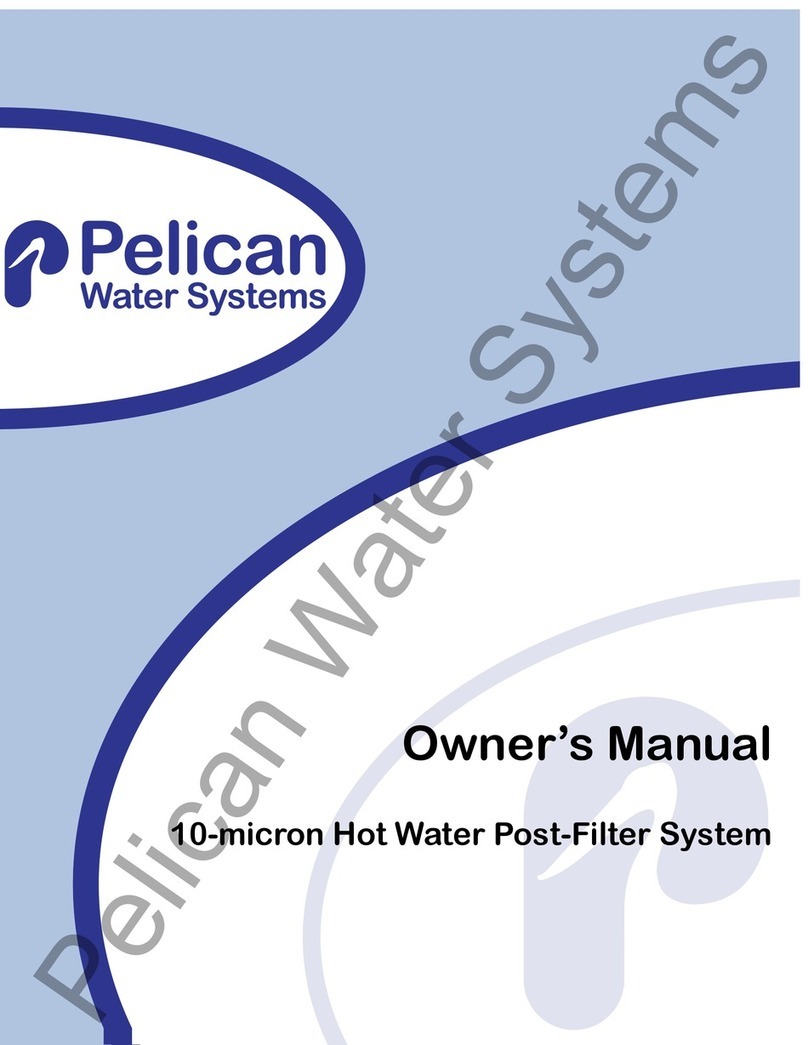
Pelican
Pelican Hot Water Post-Filter System Operation guide

Thermo Scientific
Thermo Scientific ULTROpure 682 Series Operation manual
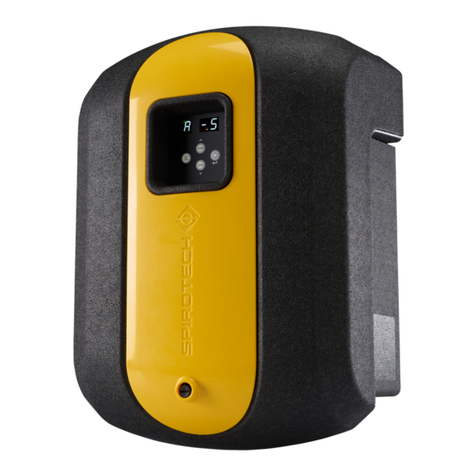
Spirotech
Spirotech SPIROVENT SUPERIOR S250 user manual
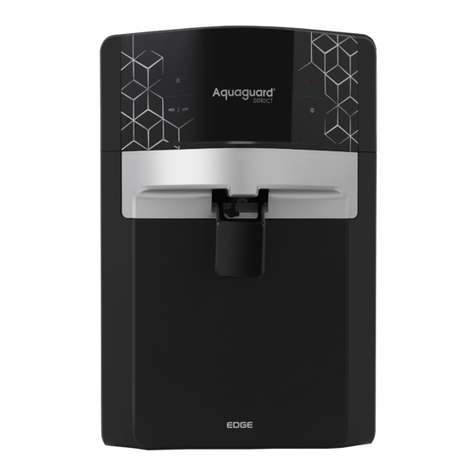
Eureka Forbes
Eureka Forbes Aquaguard Select user manual
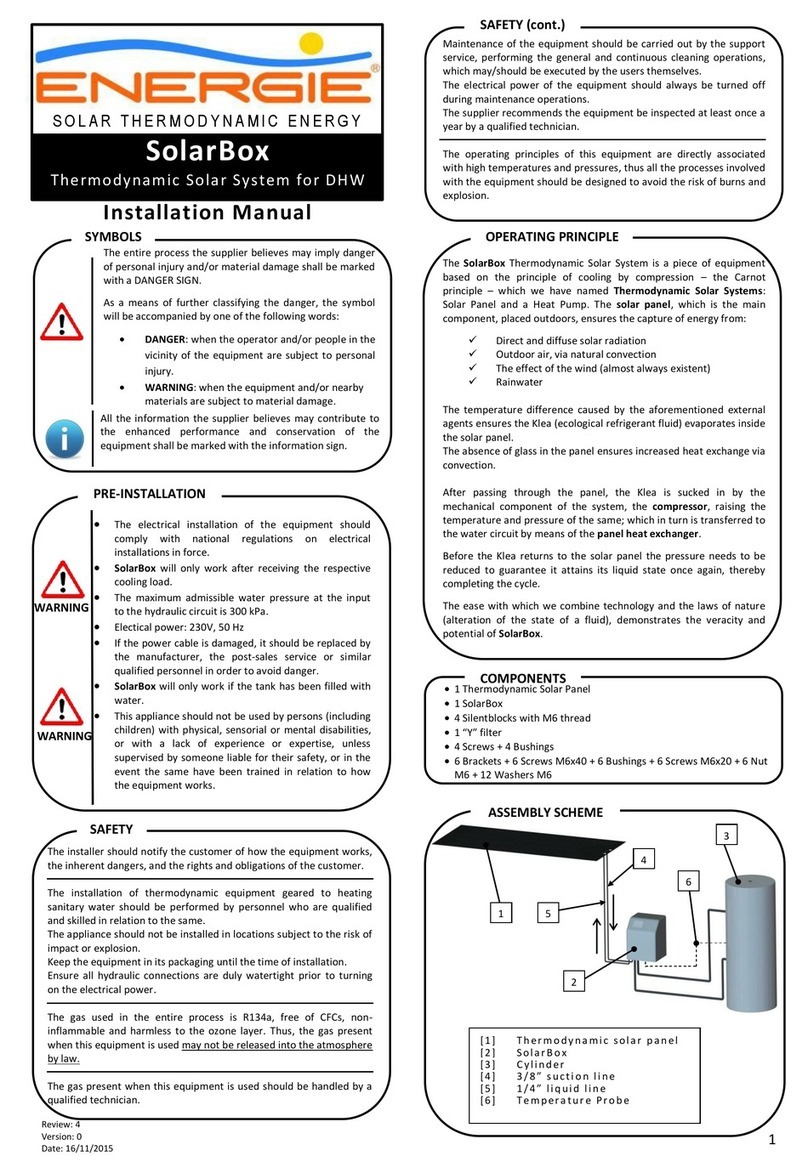
Energie
Energie SolarBox installation manual

Zenith
Zenith HydroTap G4 Installation and operating instructions
